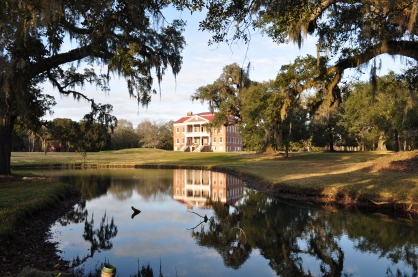South Carolina
April 22, 2012
Now South Carolina, here’s a state I can get on board with. Unlike its neighbour North Carolina, which has a southern history but has gone in a more urban, generic, modernist, could-be-anywhere in America direction, South Carolina is still very much the south. First the flag:
Good flag, no people engaged in menial tasks, just a palm tree, at night. Very few flags take place at night, so that’s a bit different. The only issue is it looks like someone’s tried to put the leaves of the tree through a shredder, but never mind.
As I was saying, South Carolina is the south, not this fancy “New South” of megapolises like Atlanta and Dallas, no, the old south, old money, estates, palm trees and old pickup trucks. We headed to Charleston which is rather more of the money and estates, than the other side, the rural side of pick ups and billboards for churches, which you can see as you drive around.
Charleston got very wealthy on the back of slavery, and in the early 19th Century a lot of the richest people in the US lived in and around Charleston, on plantation estates, where they lived in luxury while their slaves toiled in the heat. Since the south feared that slavery would eventually be banned, they rebelled and the Civil War was actually started in Charleston. As you probably know, it didn’t work out so well for the South, and it could be argued that since South Carolina is still one of the poorer states in the US, it never fully recovered its glory days.
Fort Sumter, where the first shots of the American civil war were fired in 1861:
One of the very, very few plantation estates still standing (most were destroyed by vengeful Union soldiers as punishment), this is the Drayton plantation:
But why the history lesson? Well as I’ve learned repeatedly in doing this blog that where there is history, there is good and unique food. From the cajun origins of New Orleans’ cuisine, to the Italian roots of the New York scene, where there is history there is something interesting to be eaten. South Carolina does not disappoint, and rather like New Orleans it has a whole cuisine of its own, in this case “lowcountry food”. Called the low country because of it’s marshy coastline and the fact it is near or below sea level, it has a range of associated dishes, often to do with the crustaceans and seafood that are abundant. Lots of oysters, crabs, shrimp and things like that.
In addition it melds pretty well with southern cuisine more generally, so lots of rice, grits, beans etc. We ate in a couple of great restaurants that focus on southern/low country cuisine, the Hominy Grill and Magnolias, and tried some local specialities; shecrab soup – a crab soup made with crab roe, so like a crab caviar soup, perloo – a rice dish, pimento cheese – apparently a Southern speciality, grits (in the form of baked cheese and grits) which was great, which is not a normal reaction to any kind of dish involving grits, and flounder, a fish which is common in the area.
The shecrab soup:
The baked cheese and grits, looking hash like browns:
Richard




